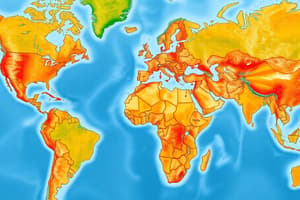Podcast
Questions and Answers
What do core areas in the core & periphery model primarily include?
What do core areas in the core & periphery model primarily include?
- Agriculture and farming
- Underdeveloped regions
- Rural communities
- Capital cities and major industries (correct)
Periphery areas are characterized by high levels of job availability and standard of living.
Periphery areas are characterized by high levels of job availability and standard of living.
False (B)
What is sustainable development?
What is sustainable development?
The ability to meet current needs without compromising the ability of future generations to meet their own needs.
If a country is only economically and socially developed, it is considered __________.
If a country is only economically and socially developed, it is considered __________.
Match the following stages of Rostow's modernization theory with their descriptions:
Match the following stages of Rostow's modernization theory with their descriptions:
Which of the following is a limitation of the core & periphery model?
Which of the following is a limitation of the core & periphery model?
Rostow's modernization theory accounts for cultural, political, and geographical differences among countries.
Rostow's modernization theory accounts for cultural, political, and geographical differences among countries.
What is the central focus of the sustainable development model?
What is the central focus of the sustainable development model?
What best describes areas in the periphery according to the core & periphery model?
What best describes areas in the periphery according to the core & periphery model?
Core areas are typically less developed than periphery areas.
Core areas are typically less developed than periphery areas.
What is meant by sustainable development?
What is meant by sustainable development?
If a country is socially and environmentally developed, it is considered __________.
If a country is socially and environmentally developed, it is considered __________.
Which of the following aspects does the sustainable development model primarily focus on?
Which of the following aspects does the sustainable development model primarily focus on?
Multiple cores can create clear boundaries between economic regions.
Multiple cores can create clear boundaries between economic regions.
What is a disadvantage of the core & periphery model?
What is a disadvantage of the core & periphery model?
Flashcards
Core-Periphery Model
Core-Periphery Model
A model showing how economic activity is distributed unevenly, with core areas having high development and periphery areas having less.
Sustainable Development
Sustainable Development
Development that meets current needs without harming future generations' ability to meet their own.
Sustainable Development Model
Sustainable Development Model
A model of development that balances economic, social, and environmental goals.
Rostow's Modernization Theory
Rostow's Modernization Theory
Signup and view all the flashcards
Traditional Society (Rostow)
Traditional Society (Rostow)
Signup and view all the flashcards
Preconditions for Take-off (Rostow)
Preconditions for Take-off (Rostow)
Signup and view all the flashcards
Core Area
Core Area
Signup and view all the flashcards
Periphery Area
Periphery Area
Signup and view all the flashcards
Equitable Development
Equitable Development
Signup and view all the flashcards
Bearable Development
Bearable Development
Signup and view all the flashcards
Viable Development
Viable Development
Signup and view all the flashcards
Study Notes
Core-Periphery Model
- Describes economic development patterns across different areas.
- Core areas: high economic activity and development (capital cities, major industries, services, investment).
- Periphery areas: less developed areas surrounding the core, with decreasing levels of development, living standards, jobs, and services as distance from the core increases.
- Explains economic growth and resource distribution on macro and micro scales.
Sustainable Development Model
- Aims for economic and social development without harming the environment.
- Key concept: meeting current needs without compromising future generations' ability to meet their needs.
- Scientific knowledge and appropriate technologies are crucial for solving economic, social and environmental problems associated with unsustainable development paths.
- Equitable development: focused on economic and social development.
- Bearable development: focused on economic and environmental development.
- Viable development: focused on social and environmental development.
Disadvantages / Limitations of the Core-Periphery Model
- Multiple cores: some countries have multiple areas of influence, making core-periphery distinctions unclear.
- Multifunctional places: areas now engage in a mix of activities, blurring the lines between core and periphery.
Rostow's Modernization Theory
- Outlines 5 stages of economic development.
- Assumes all countries follow a predictable path to economic growth.
- Ignores cultural, political, and geographical differences between countries.
Stages of Rostow's Model
- Traditional Society: Primarily agricultural, limited technology/innovation, subsistence economy.
- Preconditions for Take-Off: Shift from agriculture to manufacturing, increased trade and profit, investments in infrastructure (transportation, communication). External resources/investment often needed.
- Take-Off: Rapid industrial growth, focus on manufacturing, significant shift from agriculture, requires profit from overseas trade.
- Drive to Maturity: Continued growth, diversified economy with more industries, technological innovation, rising standards of living, improved infrastructure and institutions.
- High Mass Consumption: High productivity and wealth, strong consumer culture, widespread access to goods and services, possibly focus on military/education/luxuries.
Studying That Suits You
Use AI to generate personalized quizzes and flashcards to suit your learning preferences.




